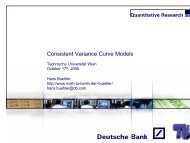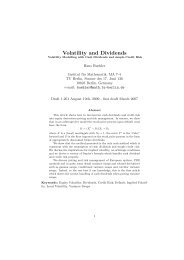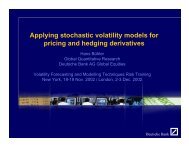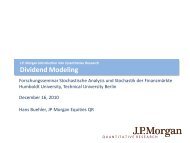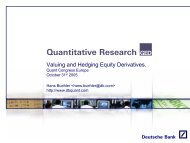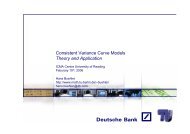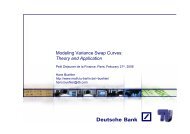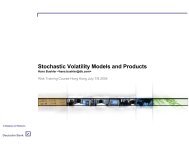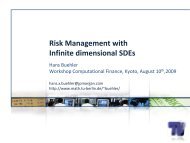Delta-Hedging Works - Market Completeness for ... - Hans Buehler
Delta-Hedging Works - Market Completeness for ... - Hans Buehler
Delta-Hedging Works - Market Completeness for ... - Hans Buehler
You also want an ePaper? Increase the reach of your titles
YUMPU automatically turns print PDFs into web optimized ePapers that Google loves.
<strong>Delta</strong>-<strong>Hedging</strong> <strong>Works</strong><br />
<strong>Market</strong> <strong>Completeness</strong> <strong>for</strong> Factor Models on the example<br />
of Variance Curve Models<br />
Conference on small time asymptotics, perturbation theory and heat kernel<br />
methods in mathematical finance<br />
Vienna, February 12 th , 2009<br />
<strong>Hans</strong> <strong>Buehler</strong><br />
http://www.math.tu-berlin.de/~buehler/<br />
hans.buehler@berlin.de<br />
Reference (apr02)
Abstract<br />
We discuss market completeness <strong>for</strong> diffusion-driven factor models beyond<br />
the classic requirement that the volatility matrix of traded instruments is<br />
invertible.<br />
We show that the market generated by a finite-dimensional<br />
diffusion model is complete as soon as the coefficients of the SDE are<br />
d⊗dP-almost surely C 1 with locally Lipschitz derivatives. As a<br />
consequence, when factor models are considered as diffusions in Hilbert<br />
spaces, then any such factor model which admits a finite dimensional<br />
representation creates a (locally) complete market.<br />
This is illustrated on the example of Variance Swap Curve <strong>Market</strong> Models.<br />
2 Reference (apr02)
<strong>Delta</strong>-<strong>Hedging</strong> <strong>Works</strong><br />
on the example of Consistent Variance Curve Models<br />
Outline<br />
Introduce generic Variance Swap Models<br />
On Hilbert Spaces<br />
<strong>Market</strong> <strong>Completeness</strong><br />
3 Reference (apr02)
Realized Variance<br />
Trading volatility<br />
4 Reference (apr02)
Realized Variance<br />
Introduction<br />
Realized variance of a stock price process S=(S t<br />
) t<br />
over business days<br />
0=t 0<br />
< …
Realized Variance<br />
Introduction<br />
252<br />
t a RV 30<br />
30<br />
( t,<br />
t + d )<br />
STOXX50E and HSI Returns and Volatilities<br />
400%<br />
120%<br />
350%<br />
300%<br />
.STOXX50E<br />
.HSI<br />
.STOXX50E 30d Vol<br />
.HSI 30d Vol<br />
100%<br />
250%<br />
80%<br />
Return<br />
200%<br />
60%<br />
Volatility<br />
150%<br />
40%<br />
100%<br />
20%<br />
50%<br />
0%<br />
Feb-99 Feb-00 Feb-01 Feb-02 Feb-03 Feb-04 Feb-05 Feb-06 Feb-07 Feb-08<br />
0%<br />
6 Reference (apr02)
Realized Variance<br />
Introduction<br />
Quadratic variation is an unbiased estimator of realized variance, ie<br />
E<br />
T<br />
t<br />
⎣ i=<br />
1<br />
(This is also true if S has a drift and potentially jumps)<br />
– Under any pricing measure<br />
[ ]<br />
n<br />
⎡<br />
2 ⎤<br />
log S ≈ E ( log S<br />
t<br />
/ S ) ⎥⎦<br />
⎢<br />
∑<br />
t<br />
t−1<br />
V (t<br />
t<br />
[ ]<br />
log S log S | F<br />
0,<br />
tn<br />
) = E −<br />
t<br />
n<br />
t<br />
0<br />
t<br />
– Prices are liquidly traded <strong>for</strong> indices (OTC).<br />
– Single stock variance swaps caused a lot of pain end of 2008<br />
7 Reference (apr02)
35<br />
Realized Variance<br />
Variance Swaps<br />
Variance Swap <strong>Market</strong> Prices<br />
Prices are quoted in<br />
“volatility”<br />
1<br />
t a Vt t,<br />
t + x<br />
x<br />
( )<br />
30<br />
25<br />
VarSwap fair strike<br />
20<br />
15<br />
1<br />
.STOXX50E 04/01/2006<br />
10<br />
.GDAXI 16/01/2006<br />
.N225 17/01/2006<br />
5<br />
.SPX 20/01/2006<br />
0<br />
0.0 0.5 1.0 1.5 2.0 2.5 3.0 3.5 4.0 4.5 5.0<br />
Years<br />
8 Reference (apr02)
Realized Variance<br />
Beyond Variance Swaps<br />
… but what about more complex products:<br />
– Straddles on realized variance<br />
RV ( 0, T ) − K<br />
2<br />
– Volatility swaps<br />
RV (0, T )<br />
−<br />
K<br />
To risk-manage such products the idea that variance swaps can be<br />
used to “delta-hedge” more complex options on realized variance.<br />
– For that, we obviously need a notion of completeness..<br />
9 Reference (apr02)
Variance Curve Models<br />
Classic Approach<br />
10 Reference (apr02)
Variance Curve Models<br />
Program<br />
1. Instead of starting with S as in classic stochastic volatility models, let<br />
us first specify the dynamics of the variance swaps.<br />
2. Then, construct a (local) martingale S which has the correct<br />
quadratic variation such that the market of variance swaps and<br />
stock is free of arbitrage.<br />
3. The correlation between the Brownian motion which drives S and<br />
the variance curve will act as a skew parameter.<br />
4. Since we are fundamentally aiming at replication, we provide criteria<br />
when the market is complete.<br />
– The latter excludes per se jumps in our discussion which are otherwise<br />
an important part of variance modelling.<br />
11 Reference (apr02)
Variance Curve Models<br />
Classic approach<br />
Assume we have a driving d-dimensional extremal Brownian motion<br />
W on the space (Ω,P,F).<br />
Recall that under any pricing measure<br />
V ( 0, T ) =<br />
t<br />
E<br />
t<br />
[ log S ]<br />
T<br />
The idea is to specify directly the dynamics of instantaneous <strong>for</strong>ward<br />
variance<br />
v<br />
( T ) = V (0, T )<br />
t<br />
∂ T<br />
very much like we specify the “<strong>for</strong>ward rates” in HJM models:<br />
f<br />
t<br />
( T ) ≈ ∂T<br />
' T ' = T<br />
log P(<br />
t,<br />
T )'<br />
t<br />
12 Reference (apr02)
Variance Curve Models<br />
Classic approach<br />
Definition<br />
A family v=(v(T)) T≥0 is called a [local] Variance Curve Model if<br />
1. For each T>0, the process v(T)=(v t<br />
(T)) t∈[0,T]<br />
is a non-negative [local]<br />
martingale:<br />
dv<br />
t<br />
j<br />
j j<br />
( T ) = ∑ =<br />
β ( T ) dW β ( T ) ∈ L<br />
j<br />
1, K,<br />
d<br />
t<br />
t<br />
loc<br />
2. For each T>0, the initial variance swap prices are finite, i.e.<br />
V (0, T ) = ∫ T v ( s)<br />
ds < ∞<br />
0<br />
0 0<br />
Set of intregrable,<br />
predictable<br />
processes wrt W.<br />
3. The curve v t<br />
(t) is left-continuous.<br />
13 Reference (apr02)
Variance Curve Models<br />
Classic approach<br />
Properties<br />
– The price processes of variance swaps,<br />
V<br />
are [local] martingales.<br />
t<br />
( T1<br />
, T2<br />
) :<br />
∫<br />
T<br />
= 2<br />
T<br />
1<br />
v<br />
t<br />
( s)<br />
ds<br />
– The short variance process<br />
ζ t<br />
: = v t<br />
( t)<br />
is well defined, integrable and non-negative.<br />
14 Reference (apr02)
Variance Curve Models<br />
Classic approach<br />
<br />
Properties<br />
Given any standard Brownian motion B on (Ω,P,F), the process<br />
dX<br />
t<br />
=<br />
ζ dB<br />
t<br />
t<br />
is a square-integrable martingale, so the via B associated stock price<br />
is a local martingale.<br />
( X X )<br />
1<br />
St<br />
: = exp<br />
t<br />
− 2<br />
– B represents the correlation structure of S with v.<br />
t<br />
<br />
Theorem<br />
For each variance curve model v and each Brownian motion B, the market<br />
is free of arbitrage.<br />
( S ( V ( T , T )) )<br />
;<br />
2 T >T ≥0<br />
1 2 1<br />
15 Reference (apr02)
Variance Curve Models<br />
Classic approach –Musiela parametrization<br />
Fixed time-to-maturity Variance Curve Movements<br />
20<br />
18<br />
1<br />
x a Vt ( t,<br />
t + x)<br />
x<br />
16<br />
14<br />
12<br />
10<br />
8<br />
x→<br />
6<br />
4<br />
2<br />
0<br />
0 1 2 3 4 5 6 7<br />
t→<br />
Floating 3m Today 1y 2y 3y 4y<br />
16 Reference (apr02)
Variance Curve Models<br />
Classic approach – Musiela-Parametrization<br />
As in interest rates, it is more convenient to work with fixed time-tomaturities<br />
x:=T-t. Hence we define the Musiela parameterization<br />
u<br />
( x)<br />
: = v ( t x)<br />
v ( T ) = u ( T − t)<br />
t t<br />
+<br />
t<br />
t<br />
Starting in Musiela-parametrization<br />
– Assume that<br />
Then,<br />
∑<br />
∞<br />
∫ ∫<br />
j=<br />
1,<br />
K,<br />
d 0<br />
t<br />
∞<br />
∂<br />
T<br />
β ( T )<br />
t<br />
2<br />
dTdt<br />
< ∞<br />
du<br />
t<br />
( x) : = ∂<br />
x<br />
u<br />
t<br />
( x)<br />
dt<br />
+∑ j =<br />
1, K,<br />
d<br />
b<br />
j<br />
t<br />
( x)<br />
dW<br />
t<br />
j<br />
defines a local variance curve model in Musiela-parametrization.<br />
17 Reference (apr02)
Variance Curve Models<br />
Classic approach – step one<br />
<br />
<br />
The previous discussion shows that it is remarkably easy to construct<br />
an arbitrage-free market with Variance Curve Models.<br />
Problems are<br />
1. The general predictable integrands are far too general<br />
1. It is difficult to check whether v remains non-negative.<br />
2. Numerically intractable.<br />
2. We would much prefer a representation in terms of a “driving” finitedimensional<br />
Markov process to actually be able to implement the model on<br />
a computer.<br />
3. Not discussed today: how do I fit an initial term structure from the market<br />
perfectly (cf. HJM models) see http://www.math.tu-berlin.de/~buehler<br />
18 Reference (apr02)
Variance Curve Models<br />
Consistency<br />
<br />
Ideally, we want to write<br />
u<br />
( x)<br />
: G(<br />
Z ; x)<br />
t<br />
=<br />
t<br />
<br />
<strong>for</strong> some suitable non-negative function G and an m-dimensional Markovprocess<br />
Z.<br />
– The function G is the “interpolation function” <strong>for</strong> the <strong>for</strong>ward variances.<br />
<br />
Key point:<br />
We first chose the function G and then try to find the space of “suitable”<br />
parameter processes Z.<br />
19 Reference (apr02)
Variance Curve Models<br />
Consistency<br />
Fixed time-to-maturity Variance Curve Movements<br />
20<br />
18<br />
1<br />
x a Vt ( t,<br />
t + x)<br />
x<br />
16<br />
14<br />
12<br />
10<br />
8<br />
x→<br />
6<br />
4<br />
2<br />
0<br />
0 1 2 3 4 5 6 7<br />
t→<br />
Floating 3m Today 1y 2y 3y 4y<br />
20 Reference (apr02)
Variance Curve Models<br />
Consistency<br />
Variance Swap Term Structure .SPX 10/12/2005<br />
24<br />
Variance Swap Fair Strike<br />
22<br />
20<br />
18<br />
16<br />
− z3x<br />
G( z;<br />
x)<br />
= z2<br />
+ ( z1<br />
− z2)<br />
e<br />
<strong>Market</strong><br />
Interpolation<br />
14<br />
12<br />
01/10/2005 01/10/2006 01/10/2007 01/10/2008 01/10/2009 01/10/2010 01/10/2011<br />
Maturity<br />
21 Reference (apr02)
Variance Curve Models<br />
Consistency<br />
Definition<br />
1. A non-negative C 2,2 -function G:DxR + →R + is called a Variance Curve<br />
Functional if<br />
∫ T<br />
G(<br />
z;<br />
x)<br />
dx < ∞<br />
0<br />
<strong>for</strong> all T and z∈D where D is an open set in R ≥0m<br />
.<br />
2. We denote by Ξ the set of all C=(µ,σ) <strong>for</strong> which the SDE<br />
dZ<br />
t<br />
= µ ( Z<br />
t<br />
) dt<br />
+∑ j =<br />
1, K,<br />
d<br />
σ<br />
j<br />
( Z<br />
t<br />
) dW<br />
t<br />
j<br />
starting at any point Z 0<br />
∈D has a unique solution Z which stays in D.<br />
– Time-dependency is included in this setup.<br />
22 Reference (apr02)
Variance Curve Models<br />
Consistency<br />
<br />
Definition<br />
We call C=(µ,σ)∈Ξ a consistent factor model <strong>for</strong> G if <strong>for</strong> any Z 0<br />
∈D,<br />
u<br />
( x)<br />
: G(<br />
Z ; x)<br />
t<br />
=<br />
t<br />
defines a local variance curve model.<br />
<br />
Theorem<br />
This is the case if and only if Z stays in D and if<br />
∂<br />
x<br />
G(<br />
z;<br />
x)<br />
= µ ( z)<br />
∂<br />
z<br />
G(<br />
z;<br />
x)<br />
+<br />
1<br />
σ<br />
2<br />
T<br />
σ ( z)<br />
∂<br />
2<br />
zz<br />
G(<br />
z;<br />
x)<br />
holds.<br />
– Note that we are given G and look <strong>for</strong> C=(µ,σ)∈Ξ contrary to common applications.<br />
23 Reference (apr02)
Variance Curve Models<br />
Consistency<br />
<br />
Local Correlation and the Markov property<br />
Given a consistent factor model C=(µ,σ)∈Ξ and a “correlation function”<br />
ρ:R + xD→[-1,1] d with |ρ|=1, we can always define<br />
dS<br />
t<br />
= ∑ j =<br />
1, K,<br />
d<br />
j<br />
S ρ ( S<br />
t<br />
t<br />
; Z<br />
t<br />
)<br />
{ }<br />
j<br />
G(<br />
Z ;0) dW<br />
t<br />
t<br />
such that the process (S,Z) is Markov and S is a local martingale (note that<br />
the SDE does not explode).<br />
– The Markov property is essential <strong>for</strong> market completeness as we will see later.<br />
– Local-Stochastic volatility “mixture models” are also part of this framework<br />
24 Reference (apr02)
Variance Curve Models<br />
Consistency – Examples<br />
Example<br />
A very basic example is the “linearly mean-reverting” functional:<br />
„Speed of mean-reversion“<br />
− z3x<br />
G( z;<br />
x)<br />
= z2<br />
+ ( z1<br />
− z2)<br />
e<br />
„Short variance“<br />
„Long variance“<br />
<strong>for</strong> z 1 ≥0 and z 2 ,z 3 >0.<br />
25 Reference (apr02)
Variance Curve Models<br />
Consistency – Linear mean-reversion<br />
For the other two parameters, we find that while σ is unconstrained,<br />
µ ( z)<br />
= 0<br />
2<br />
µ ( z)<br />
=<br />
1<br />
z<br />
3<br />
( z<br />
2<br />
−<br />
z<br />
1<br />
)<br />
In other words: the only consistent processes <strong>for</strong> this choice of G are<br />
of Heston-type<br />
dζ<br />
dθ<br />
t<br />
t<br />
=<br />
=<br />
Mean-reversion level θ is a<br />
positive martingale.<br />
κ(<br />
θ −ζ<br />
) dt + σ ( ζ , θ ) dW<br />
t<br />
σ ( ζ , θ ) dW<br />
2<br />
t<br />
t<br />
t<br />
Linear mean-reversion drift<br />
t<br />
1<br />
t<br />
t<br />
t<br />
VolOfVol can freely be<br />
chosen as long as ζ<br />
remains non-negative.<br />
26 Reference (apr02)
Variance Curve Models<br />
Consistency<br />
<br />
Proposition<br />
The observation that mean-reversion speeds must be constant holds <strong>for</strong> all<br />
polynomial-exponential functionals, i.e. if (p i<br />
) i<br />
are polynomials<br />
+<br />
= ∑<br />
−<br />
G( z1 , K,<br />
zn,<br />
zn<br />
1,.<br />
K,<br />
zm;<br />
x)<br />
=<br />
pi<br />
( z;<br />
x)<br />
e<br />
then the first n components must be constant (cf. Filipovic 2001 <strong>for</strong> interest<br />
rates).<br />
n<br />
i<br />
1<br />
z<br />
i<br />
x<br />
<br />
A similarly restrictive result can be shown <strong>for</strong> functionals of the <strong>for</strong>m<br />
G(<br />
z<br />
, K,<br />
z<br />
, z<br />
+ 1,.<br />
K,<br />
zm;<br />
x)<br />
=<br />
exp<br />
{ }<br />
n<br />
z x<br />
p ( z;<br />
x)<br />
e<br />
∑<br />
−<br />
1 n n<br />
i = 1 i<br />
i<br />
– The parameters in the exponent come in pairs, where one is twice as large as the<br />
other (again Filipovic 2001).<br />
27 Reference (apr02)
Variance Curve Models<br />
Consistency – Example linear mean-reversion<br />
<br />
Another example of the polynomial-exponential class is<br />
G<br />
−κx<br />
( z;<br />
x)<br />
= z3<br />
+ ( z1<br />
− z2<br />
) e + ( z2<br />
− z3)<br />
κ<br />
κ<br />
− c<br />
(<br />
−cx<br />
−κx<br />
e − e )<br />
– A consistent factor model <strong>for</strong> this G must have the <strong>for</strong>m<br />
dZ<br />
dZ<br />
dZ<br />
1<br />
t<br />
2<br />
t<br />
3<br />
t<br />
=<br />
=<br />
=<br />
κ(<br />
Z<br />
c(<br />
Z<br />
2<br />
t<br />
3<br />
t<br />
σ ( Z<br />
3<br />
− Z<br />
t<br />
− Z<br />
1<br />
t<br />
2<br />
t<br />
) dW<br />
) dt + σ ( Z<br />
) dt + σ ( Z<br />
t<br />
1<br />
2<br />
t<br />
t<br />
) dW<br />
t<br />
) dW<br />
t<br />
which we call “double mean-reverting”.<br />
– Quite a good fit <strong>for</strong> most indices (at least up to Mid-2007)<br />
28 Reference (apr02)
Variance Curve Models<br />
Consistency – Example linear mean-reversion<br />
Variance Swap Term Structure .SPX 10/12/2005<br />
24<br />
22<br />
Variance Swap Fair Strike<br />
20<br />
18<br />
16<br />
14<br />
− z3x<br />
G( z;<br />
x)<br />
= z2<br />
+ ( z1<br />
− z2)<br />
e<br />
G<br />
−κx<br />
( z;<br />
x)<br />
= z3<br />
+ ( z1<br />
− z2<br />
) e + ( z2<br />
− z3)<br />
κ<br />
κ<br />
− c<br />
−cx<br />
−κx<br />
( e − e )<br />
<strong>Market</strong><br />
Heston<br />
Double Heston<br />
12<br />
01/10/2005 01/10/2006 01/10/2007 01/10/2008 01/10/2009 01/10/2010 01/10/2011<br />
Maturity<br />
29 Reference (apr02)
Variance Curve Models<br />
Consistency – Example linear mean-reversion<br />
Such a 4F (3 SV + stock) model is discussed in “Volatility <strong>Market</strong>s” (2006;<br />
2009)<br />
<br />
Intuitively, a more-factor model is only necessary if we want to price<br />
options on variance swaps etc.<br />
30 Reference (apr02)
Variance Curve Models<br />
Term-structure approach<br />
The next logical step is to model the entire curve u as a process with<br />
values in a Hilbert space H.<br />
– We follow the path laid by Bjoerk/Christensen (1999), Filipovic (2000),<br />
Filipovic/Teichmann (2004) and Teichmann (2005).<br />
31 Reference (apr02)
Variance Curve Models in Hilbert Spaces<br />
Classic Approach<br />
32 Reference (apr02)
Variance Curve Models<br />
Term-structure approach<br />
Let H be a Hilbert space and assume that the variance curve u is<br />
given as a mild solution in H up to η>0 of<br />
du<br />
t<br />
= ∂<br />
x<br />
u<br />
t<br />
dt<br />
+∑ j =<br />
1, K,<br />
d<br />
b<br />
j<br />
( u<br />
t<br />
) dW<br />
t<br />
j<br />
where the coefficients b are locally Lipschitz vector fields and u is<br />
smooth. We denote by the explosion time.<br />
A finite dimensional representation (FDR) of u is a smooth function G<br />
and a finite-dimensional diffusion Z such that locally<br />
u<br />
t<br />
( ⋅)<br />
= G(<br />
Z ; ⋅)<br />
t<br />
as elements in H.<br />
33 Reference (apr02)
Variance Curve Models<br />
Term-structure approach<br />
The main difference between variance curves and <strong>for</strong>ward curves is<br />
that the curves u must remain non-negative (but can become zero).<br />
– The problem is that the “non-negative cone” is a very small set.<br />
Indeed it has no interior points.<br />
– However, if G(D) is a (positive) sub-manifold of H with boundary, then it is<br />
sufficient to check whether u stays in G(D).<br />
In this case we say G(D) is locally invariant <strong>for</strong> u.<br />
– If G is moreover invertible, we can also directly construct a (locally)<br />
consistent factor model C=(µ,σ) <strong>for</strong> G.<br />
Use Filipovic/Teichmann 2004<br />
34 Reference (apr02)
Variance Curve Models<br />
Term-structure approach<br />
<br />
The Stratonovic-drift <strong>for</strong> u is as usual<br />
Frechet-Derivative<br />
such that<br />
0<br />
β ( u)<br />
: = ∂<br />
du<br />
t<br />
=<br />
ˆ β<br />
0<br />
x<br />
( u<br />
t<br />
u<br />
−∑<br />
j<br />
=<br />
Dβ<br />
( u)<br />
⋅<br />
) dt<br />
j<br />
1, K,<br />
d<br />
+∑ j =<br />
1, K,<br />
d<br />
ˆ j<br />
β<br />
( u<br />
j<br />
β<br />
t<br />
( u)<br />
) o dW<br />
t<br />
j<br />
Stratonovic-Integral<br />
35 Reference (apr02)
Variance Curve Models<br />
Term-structure approach<br />
Theorem (Filipovic/Teichmann 2004)<br />
The sub-manifold G(D) is locally invariant <strong>for</strong> u iff<br />
1. We have G(D)⊂dom(∂x),<br />
2. In the interior of G(D), we have<br />
ˆ j<br />
β<br />
( u)<br />
∈T<br />
u<br />
G(<br />
D)<br />
j = 0, K,<br />
d<br />
G(D)<br />
(T u<br />
G(D))<br />
3. On the boundary ∂G(D),<br />
ˆ 0<br />
β<br />
ˆ j<br />
β<br />
holds.<br />
( u)<br />
∈(<br />
T<br />
( u)<br />
∈T<br />
u<br />
u<br />
G(<br />
D))<br />
∂G(<br />
D)<br />
≥0<br />
j<br />
= 1, K,<br />
d<br />
x<br />
T x<br />
G(D)<br />
36 Reference (apr02)
Variance Curve Models<br />
Term-structure approach<br />
If we can invert G, then C=(µ,σ) with<br />
µ ( z)<br />
: = ∂<br />
z<br />
G<br />
−1<br />
j<br />
σ ( z)<br />
: = ∂<br />
ˆ 0<br />
( β<br />
∑ j = 1,.. d<br />
is a locally consistent factor model <strong>for</strong> G, i.e.<br />
z<br />
G<br />
( G)(<br />
z(<br />
z))<br />
u<br />
−1<br />
+<br />
ˆ j<br />
( β<br />
( G(<br />
z))<br />
( ∂<br />
( x)<br />
G(<br />
Z ; x)<br />
t<br />
=<br />
t<br />
z<br />
σ<br />
j<br />
)( z)<br />
σ<br />
j<br />
( z)<br />
<strong>for</strong><br />
dZ<br />
t<br />
= µ ( Z<br />
t<br />
) dt<br />
+∑ j =<br />
1, K,<br />
d<br />
σ<br />
j<br />
( Z<br />
t<br />
) dW<br />
t<br />
j<br />
37 Reference (apr02)
<strong>Market</strong> <strong>Completeness</strong> in Factor Models<br />
”<strong>Delta</strong> <strong>Hedging</strong> <strong>Works</strong>”<br />
38 Reference (apr02)
<strong>Market</strong> <strong>Completeness</strong> in Factor Models<br />
Basics<br />
Assume a market with state process X=(S 1 ,…,S K ;A 1 ,…,A M ) given by<br />
the SDE<br />
dS<br />
dA<br />
t<br />
t<br />
d<br />
= ∑ j = 1<br />
= µ ( S<br />
t<br />
t<br />
Σ<br />
t<br />
( S<br />
t<br />
t<br />
, A ) dt<br />
, A ) dW<br />
t<br />
i<br />
t<br />
– S are the tradables in this market<br />
– A are auxiliary state variables with finite variation (e.g. quadratic<br />
variation)<br />
– This represents a collection of instruments (typically K>>d) and some<br />
auxiliary variables such that the market is Markov.<br />
When is this market complete?<br />
39 Reference (apr02)
<strong>Market</strong> <strong>Completeness</strong> in Factor Models<br />
Basics<br />
Classic Definition of market completeness:<br />
Ability to replicate all payoffs (L 1 random variables H≥0) which are<br />
measurable with respect to a reference filtration on which W is<br />
extremal.<br />
Idea:<br />
– Define the martingale H as H t<br />
:=E t<br />
[ H ].<br />
– Invoke PRP of W to obtain η such that<br />
dH<br />
t<br />
= ∑<br />
d<br />
j =<br />
η j<br />
dW<br />
1 t<br />
t<br />
j<br />
– If Σ(S t,<br />
A t<br />
) -1 is S-integrable, then dW t<br />
= Σ(S t,<br />
A t<br />
) -1 dS t<br />
exists, and we obtain<br />
( )<br />
j<br />
−1<br />
Σ(<br />
S<br />
= ∑<br />
t, At<br />
) dSt<br />
:<br />
∑<br />
d j<br />
K<br />
η<br />
j=<br />
1<br />
i=<br />
dH<br />
t<br />
=<br />
h<br />
t 1<br />
i<br />
t<br />
dS<br />
i<br />
t<br />
40 Reference (apr02)
<strong>Market</strong> <strong>Completeness</strong> in Factor Models<br />
Basics<br />
The issue is that this requires that Σ has full rank.<br />
– This is often violated, in particular in Heston-type models.<br />
– Allows only one hedging instrument <strong>for</strong> 1F diffusions<br />
The scope of this approach is also too wide:<br />
– We are usually not interested in general W-measurable payoffs:<br />
we want to replicate payoffs which are functional <strong>for</strong>ms of the path of<br />
market observables<br />
measurable w.r.t. the filtration generated by X=(S,A).<br />
41 Reference (apr02)
<strong>Market</strong> <strong>Completeness</strong> in Factor Models<br />
Relevant Payoffs<br />
Definition:<br />
The market of relevant payoffs is the market of all L 1 random<br />
variables H≥0 which are measurable wrt to Y.<br />
– We call the smallest T such that H∈F T<br />
(S,A) the maturity of H.<br />
– We also define H t<br />
:=E t<br />
[ H ]<br />
We say the market of relevant payoffs is complete if <strong>for</strong> all F T (S,A)-<br />
measurable H we find an locally S-integrable h such that<br />
[ H ] ∑<br />
K<br />
+ ∫ i=<br />
H = E<br />
1 0<br />
T<br />
h i<br />
dS i<br />
t t<br />
(each claim H is replicable with S).<br />
42 Reference (apr02)
<strong>Market</strong> <strong>Completeness</strong> in Factor Models<br />
<strong>Delta</strong> <strong>Hedging</strong> <strong>Works</strong><br />
Definition: if X is a n-dimensional non-explosive diffusion<br />
such that<br />
dX<br />
t<br />
= µ ( X<br />
t<br />
) dt<br />
+∑<br />
d<br />
=<br />
Σ<br />
Pft ( x)<br />
: = E[ f ( X<br />
T<br />
) | X<br />
t<br />
= x]<br />
j<br />
1<br />
j<br />
( X<br />
t<br />
) dW<br />
i<br />
t<br />
is d⊗dP-almost surely C 1 <strong>for</strong> all f∈C K<br />
∞ (∗)<br />
, then we say X weakly<br />
preserves smoothness.<br />
43 Reference (apr02)<br />
(*) smooth with compact support
<strong>Market</strong> <strong>Completeness</strong> in Factor Models<br />
<strong>Delta</strong> <strong>Hedging</strong> <strong>Works</strong><br />
Theorem: if X is weakly preserves smoothness, then X is<br />
extremal on its own filtration, i.e. <strong>for</strong> all integrable non-negative<br />
H∈F T (X) there exist locally X-integrable processes h such that<br />
with<br />
S<br />
H<br />
=<br />
(we say H is replicable).<br />
i<br />
t<br />
=<br />
=<br />
E<br />
[ ] ∑<br />
N<br />
H + ∫ i=<br />
X<br />
X<br />
i<br />
t<br />
i<br />
0<br />
−<br />
+<br />
∫<br />
t<br />
i<br />
µ<br />
0<br />
d<br />
– Moreover, if H t<br />
(x) := E t<br />
[ H | X t<br />
=x ] is differentiable, then the integrands<br />
are “<strong>Delta</strong>”, i.e. h t<br />
= ∂ X<br />
H t<br />
(X t<br />
).<br />
T<br />
1 0<br />
( X<br />
∑ ∫ j=<br />
t<br />
1 0<br />
t<br />
Σ<br />
h i dS<br />
t<br />
) dt<br />
i,<br />
j<br />
i<br />
t<br />
( X<br />
t<br />
) dW<br />
j<br />
t<br />
44 Reference (apr02)
<strong>Market</strong> <strong>Completeness</strong> in Factor Models<br />
<strong>Delta</strong> <strong>Hedging</strong> <strong>Works</strong><br />
Let (φ n ) n be a Dirac Sequence of non-negative smooth functions<br />
with compact support and ∫φ n (x) dx=1.<br />
Let f be a Lebesgue-measurable function and<br />
f<br />
( y)<br />
: = f ( x)<br />
φ ( y − x dx<br />
∫<br />
n n<br />
)<br />
– Then f n<br />
is smooth and f n<br />
→ f in L p (λ) <strong>for</strong> 1≤p
<strong>Market</strong> <strong>Completeness</strong> in Factor Models<br />
<strong>Delta</strong> <strong>Hedging</strong> <strong>Works</strong><br />
Step 1: if X is bounded, then each H(X T ) <strong>for</strong> H≥0 in C K∞<br />
– Define<br />
is replicable.<br />
H<br />
( x)<br />
: = E[ H(<br />
X ) | X x]<br />
t T t<br />
=<br />
which is continuous and d⊗dP-almost surely C 1 .<br />
– Assume H t<br />
is C 2 , then Ito and the local martingale property yield<br />
H(<br />
X<br />
T<br />
) =<br />
E[ H(<br />
X<br />
)] +<br />
<strong>for</strong> the bounded local martingales S.<br />
T<br />
n<br />
T<br />
∑ ∫ i=<br />
1<br />
0<br />
∂<br />
X<br />
i<br />
H<br />
t<br />
( X<br />
t<br />
) dS<br />
i<br />
t<br />
46 Reference (apr02)
<strong>Market</strong> <strong>Completeness</strong> in Factor Models<br />
<strong>Delta</strong> <strong>Hedging</strong> <strong>Works</strong><br />
– Define the smooth bounded functions<br />
<strong>for</strong> which<br />
H<br />
– Since H n → H in L 2 , the left hand side converges in L 2 to a martingale.<br />
– This is implies convergence L 2 (d⊗dP) – Null-sets can be ignored.<br />
– To show that indeed L 2 ,<br />
( x)<br />
: = ∫ H x′<br />
x − x′<br />
dx′<br />
t<br />
( ) φn<br />
(<br />
n<br />
t<br />
)<br />
⎧<br />
1 ⎫<br />
= ⎨<br />
µ σ σ ⎬<br />
⎩<br />
2 ⎭<br />
n<br />
n<br />
n<br />
2 n T<br />
n<br />
dH<br />
t<br />
( X<br />
t<br />
) ∂<br />
t<br />
H<br />
t<br />
+ ∂<br />
a<br />
H<br />
t<br />
+ ∂<br />
SS<br />
H<br />
t<br />
( X<br />
t<br />
) dt + ∂<br />
xH<br />
t<br />
( X<br />
t<br />
)<br />
∫<br />
T<br />
0<br />
∂<br />
S<br />
H<br />
n<br />
t<br />
dS<br />
t<br />
we find a localizing sequence which bounds X, i.e. the derivatives on the left.<br />
Then apply properties of Dirac-Sequence.<br />
→<br />
∫<br />
T<br />
0<br />
∂<br />
S<br />
H<br />
t<br />
dS<br />
t<br />
dS<br />
t<br />
47 Reference (apr02)
<strong>Market</strong> <strong>Completeness</strong> in Factor Models<br />
<strong>Delta</strong> <strong>Hedging</strong> <strong>Works</strong><br />
Step 2: if X is bounded then any H(X T ) in L 2 is replicable.<br />
– Use a Dirac Sequence to obtain smooth H n<br />
with compact support each of<br />
which we can replicate.<br />
H<br />
n<br />
=<br />
E<br />
[ ] ∑<br />
K<br />
H + ∫<br />
n i=<br />
T<br />
1 0<br />
i,<br />
n i<br />
h<br />
t<br />
dS<br />
t<br />
– The left hand side converges in L 2 , hence the right hand integrands h n<br />
converge in d⊗dP.<br />
Step 3: if X is bounded, then any H(X T1 ;…; X Tn ) in L 2 is replicable.<br />
– Conditional expectations<br />
48 Reference (apr02)
<strong>Market</strong> <strong>Completeness</strong> in Factor Models<br />
<strong>Delta</strong> <strong>Hedging</strong> <strong>Works</strong><br />
Step 4: if X is bounded, then any H in L 2 is replicable.<br />
– Take a countable representation {t k<br />
} k<br />
of Q (the rational numbers).<br />
– For each set {t 1<br />
,…t m<br />
}, define the L 2 payoffs<br />
[ H | X , X ]<br />
m<br />
H = E K t<br />
,<br />
1<br />
– Apply Step 3 to get a representation <strong>for</strong> each H m .<br />
– Take the limit in L 2 (tower law) to yield a representation <strong>for</strong> H.<br />
t m<br />
Step 5: if X is a local martigale then any H in L 1 is replicable<br />
– Localize X and H jointly (extremality is a local property).<br />
49 Reference (apr02)
<strong>Market</strong> <strong>Completeness</strong> in Factor Models<br />
<strong>Delta</strong> <strong>Hedging</strong> <strong>Works</strong><br />
Question:<br />
When does a non-explosive diffusion (say, with (µ,Σ) locally Lipschitz)<br />
weakly preserve smoothness?<br />
Lemma<br />
Assume that X is a unique, strong, non-explosive solution to<br />
dX<br />
t<br />
= µ ( X<br />
t<br />
) dt<br />
+∑<br />
d<br />
=<br />
Σ<br />
j<br />
1<br />
j<br />
( X<br />
t<br />
) dW<br />
t<br />
j<br />
and that (µ,Σ) is C 1 with locally Lipschitz derivatives.<br />
Then, X weakly preserves smoothness.<br />
50 Reference (apr02)
<strong>Market</strong> <strong>Completeness</strong> in Factor Models<br />
<strong>Delta</strong> <strong>Hedging</strong> <strong>Works</strong><br />
Proof:<br />
– Let X 0<br />
=x. The “derived” processes<br />
exist and are of the <strong>for</strong>m<br />
X<br />
k<br />
t<br />
: = ( ∂ X , K,<br />
∂<br />
x<br />
k<br />
X<br />
1 n<br />
t<br />
k<br />
x t<br />
)<br />
dX<br />
k<br />
t<br />
=<br />
∑<br />
{ }<br />
d j<br />
j<br />
∂ µ ( X ) dt + ∂ Σ ( X ) dW<br />
∑<br />
n r,<br />
k<br />
X<br />
i= t i<br />
1 x t<br />
j=<br />
1<br />
x<br />
i<br />
t<br />
t<br />
– The coefficients are locally Lipschitz, i.e. this equation has a solution.<br />
– Since X does not explode, neither do the derived processes.<br />
– For f in C K∞ that means that by taking the limit through the expection,<br />
∂<br />
x<br />
is well-defined.<br />
[ ( )] E[ ( )] E[ '(<br />
)]<br />
r<br />
f X = ∂ f X X f X<br />
r E<br />
r =<br />
t<br />
x<br />
t<br />
t<br />
t<br />
51 Reference (apr02)
<strong>Market</strong> <strong>Completeness</strong> in Factor Models<br />
<strong>Delta</strong> <strong>Hedging</strong> <strong>Works</strong><br />
Theorem (All factor models are locally extremal)<br />
If the mild solution u in H to<br />
du<br />
t<br />
= ∂<br />
x<br />
u<br />
t<br />
dt<br />
+∑ j =<br />
1, K,<br />
d<br />
b<br />
j<br />
( u<br />
t<br />
) dW<br />
t<br />
j<br />
admits a Finite Dimensional Representation (G,Z), with a locally<br />
invertible G, then the market of relevant payoffs is locally extremal,<br />
i.e. there exists a common stopping time τ>0, such that <strong>for</strong> all L 1<br />
random variables H≥0 which are measurable wrt to u, there are<br />
locally integrable processes h such that<br />
E<br />
[ ] [ ] ∑<br />
n<br />
H = E H + ∫ i=<br />
`<br />
τ<br />
τ<br />
µ<br />
1 0<br />
i i i<br />
ht<br />
( dZt<br />
− ( Zt<br />
) dt )<br />
0<br />
– Proof: as seen be<strong>for</strong>e, µ and Σ are at least C 2 .<br />
52 Reference (apr02)
<strong>Market</strong> <strong>Completeness</strong> in Factor Models<br />
<strong>Delta</strong> <strong>Hedging</strong> <strong>Works</strong><br />
Question: can we do better <strong>for</strong> the case:<br />
dX<br />
t<br />
= ∑<br />
d<br />
=<br />
Σ<br />
j<br />
1<br />
j<br />
( X<br />
t<br />
) dW<br />
j<br />
t<br />
Or can we find an example of locally Lipschitz S with global solution X<br />
which does not preserve smoothness weakly …?<br />
53 Reference (apr02)
<strong>Market</strong> <strong>Completeness</strong> in Factor Models<br />
<strong>Delta</strong> <strong>Hedging</strong> <strong>Works</strong><br />
Theorem (“<strong>Delta</strong>-<strong>Hedging</strong> works”)<br />
Assume that X=(S,A) is a strong, unique, non-explosive solution to<br />
dS<br />
dA<br />
t<br />
t<br />
d<br />
= ∑ j = 1<br />
= µ ( S<br />
t<br />
t<br />
Σ<br />
j<br />
t<br />
( S<br />
t<br />
t<br />
,<br />
, A ) dt<br />
A ) dW<br />
t<br />
j<br />
t<br />
i.e. the vector S represents the tradable instruments in the market.<br />
– If S weakly preserves smoothness, then the market of all relevant payoffs is<br />
complete.<br />
– If (µ,Σ) is C 1 with local Lipschitz derivatives, then the market of all relevant<br />
payoffs is complete.<br />
54 Reference (apr02)
<strong>Market</strong> <strong>Completeness</strong> in Factor Models<br />
<strong>Delta</strong> <strong>Hedging</strong> <strong>Works</strong><br />
The actual statement of the previous theorem is:<br />
– The generic process X is the background diffusion (<strong>for</strong> example our<br />
consistent variance curve model).<br />
dX<br />
t<br />
=<br />
µ ( X<br />
t<br />
) dt<br />
+∑<br />
d<br />
=<br />
Σ<br />
j<br />
1<br />
j<br />
( X<br />
t<br />
) dW<br />
i<br />
t<br />
- Its properties decide whether the basic in<strong>for</strong>mation structure is extremal.<br />
- But “replication” can only work if there are tradable instruments.<br />
– Hence In order to obtain a complete market, we need to be able to express<br />
our tradables S as a Markov process<br />
dS<br />
dA<br />
t<br />
t<br />
d<br />
= ∑ j = 1<br />
= µ ( S<br />
t<br />
t<br />
Σ<br />
j<br />
t<br />
( S<br />
t<br />
t<br />
,<br />
, A ) dt<br />
A ) dW<br />
t<br />
j<br />
t<br />
55 Reference (apr02)
<strong>Market</strong> <strong>Completeness</strong> in Factor Models<br />
Consistent Variance Curve Models<br />
<br />
We are back in our initial classical setting, i.e. we have decided to use a<br />
consistent variance curve model such that<br />
dZ<br />
u<br />
t<br />
=<br />
( x)<br />
G(<br />
Z ; x)<br />
t<br />
=<br />
µ ( Z<br />
t<br />
) dt<br />
t<br />
+∑ j =<br />
1, K,<br />
d<br />
σ j<br />
( Z<br />
t<br />
) dW<br />
t<br />
j<br />
<br />
Assume that Z preserves smoothness weakly.<br />
56 Reference (apr02)
<strong>Market</strong> <strong>Completeness</strong> in Factor Models<br />
Consistent Variance Curve Models<br />
<br />
Define the variance swap price function<br />
and assume that<br />
is invertible.<br />
G ( z;<br />
x) : = x G(<br />
z;<br />
y)<br />
dy<br />
∫<br />
G z) : ( G ( z;<br />
t ), K,<br />
G ( z;<br />
t<br />
m<br />
t<br />
, K , t<br />
( =<br />
1<br />
0<br />
1 m<br />
))<br />
57 Reference (apr02)
<strong>Market</strong> <strong>Completeness</strong> in Factor Models<br />
Consistent Variance Curve Models<br />
<br />
Define K≥m tradables<br />
1<br />
K<br />
S = V ( T ), K,<br />
S : = V ( T<br />
:<br />
1<br />
K<br />
)<br />
and the finite variation auxiliary process<br />
A<br />
t<br />
= ∫<br />
t G(<br />
Zu<br />
0<br />
;0) du<br />
such that<br />
t<br />
(<br />
1<br />
K<br />
S − A , S A )<br />
Z = G<br />
−<br />
K<br />
−1<br />
T − t,<br />
K,<br />
T −t<br />
t t<br />
,<br />
1<br />
K<br />
t<br />
t<br />
Variance swap<br />
Running realized variance<br />
(if T i<br />
<strong>Market</strong> <strong>Completeness</strong> in Factor Models<br />
Consistent Variance Curve Models<br />
For example, to replicate an option on variance<br />
H<br />
t<br />
T<br />
T<br />
= C<br />
⎡<br />
⎤<br />
=<br />
⎡<br />
⎜<br />
⎛<br />
⎟<br />
⎞<br />
⎜<br />
⎛<br />
t<br />
( Zt<br />
, At<br />
) : = E h<br />
+<br />
⎢⎣ ⎝∫ζ<br />
sds<br />
Zt<br />
; At<br />
E h<br />
⎠ ⎥⎦ ⎢⎣ ⎝∫ζ<br />
sds<br />
0<br />
t<br />
A<br />
t<br />
⎟<br />
⎞<br />
⎠<br />
Z<br />
t<br />
⎤<br />
⎥⎦<br />
we can write it as<br />
C<br />
t<br />
~<br />
( Zt<br />
, Vt<br />
( t))<br />
≡ Ct<br />
( Vt<br />
( T1 ), K,<br />
Vt<br />
( Tm<br />
), At<br />
)<br />
Since G is C 2 and because Z weakly preserves smoothness, we get<br />
~<br />
dC<br />
t<br />
( L)<br />
= ∑<br />
K<br />
=<br />
∂<br />
i<br />
1<br />
V<br />
i<br />
~<br />
C<br />
t<br />
( L)<br />
dV<br />
t<br />
( T<br />
i<br />
)<br />
59 Reference (apr02)
<strong>Market</strong> <strong>Completeness</strong> in Factor Models<br />
Consistent Variance Curve Models<br />
<br />
This<br />
dC<br />
t<br />
( L)<br />
= ∑ =<br />
∂ C ( L)<br />
dV<br />
is the desired hedge in terms of variance swaps.<br />
K<br />
i<br />
1<br />
– For options on variance, this is a “natural” hedge.<br />
– It can also be used <strong>for</strong> standard options (a delta-term <strong>for</strong> S will appear).<br />
V<br />
i<br />
t<br />
t<br />
( T )<br />
i<br />
<br />
– For <strong>for</strong>ward started options, correlation (skew) risk should be taken into<br />
account.<br />
In practise, the above “VarSwap<strong>Delta</strong>” hedging ratios are computed via<br />
bumping of the variance swap price.<br />
60 Reference (apr02)
<strong>Market</strong> <strong>Completeness</strong> in Factor Models<br />
<strong>Delta</strong> <strong>Hedging</strong> <strong>Works</strong><br />
Theorem (All Variance Curve Factor Models are Locally Complete)<br />
If the mild solution u in H to<br />
du<br />
t<br />
admits a Finite Dimensional Representation (G,Z), with an invertible<br />
G and C 2 b, then the market of relevant payoffs is locally complete,<br />
i.e. there exists a common stopping time τ>0, and a set of maturities<br />
T 1 ,…,T K such that <strong>for</strong> all L 1 random variables H≥0 which are<br />
measurable wrt to u, there are locally integrable processes h such<br />
that<br />
E<br />
= ∂<br />
τ<br />
x<br />
u<br />
t<br />
dt<br />
+∑ j =<br />
1, K,<br />
d<br />
[ ] [ ] ∑<br />
K<br />
H = E H + ∫ i=<br />
`<br />
b<br />
τ<br />
i<br />
ht<br />
dVt<br />
( T )<br />
0 1 i<br />
0<br />
j<br />
( u<br />
t<br />
) dW<br />
t<br />
j<br />
– Proof: invertibility and smoothness of G.<br />
61 Reference (apr02)
Thank you very much <strong>for</strong> your attention.<br />
Details on the material presented here can be found in “Volatility <strong>Market</strong>s:<br />
Consistent Modeling, <strong>Hedging</strong> and Practical Implementation of Variance Swap<br />
<strong>Market</strong> Models”, VDM Verlag (2009).<br />
A <strong>for</strong>thcoming working paper is planned on market completeness.<br />
http://www.math.tu-berlin.de/~buehler/<br />
hans.buehler@berlin.de<br />
62 Reference (apr02)
References<br />
– T.Bjoerk, B. Christenssen: "Interest rate dynamics and consistent <strong>for</strong>ward rate<br />
curves", Mathematical Finance, 9:4, 323-348, 1999.<br />
– H.<strong>Buehler</strong>: “Consistent Variance Curve Models”, Finance and Stochastics, 2006<br />
– H.<strong>Buehler</strong>: “Volatility <strong>Market</strong>s: Consistent Modelling, <strong>Hedging</strong> and Practical<br />
Implementation of Variance Swap <strong>Market</strong> Models”, VDM 2009<br />
– D.Filipovic, Consistency Problems <strong>for</strong> Heath-Jarrow-Morton Interest Rate Models<br />
(Lecture Notes in Mathematics 1760), Springer-Verlag, Berlin, 2001<br />
– D.Filipovic, J.Teichmann: “Existence of invariant Manifolds <strong>for</strong> Stochastic Equations<br />
in infinite dimension”, Journal of Functional Analysis 197, 398-432, 2003.<br />
– D.Filipovic, J.Teichmann: “On the Geometry of the Term structure of Interest<br />
Rates”, Proceedings of the Royal Society London A 460, 129-167, 2004.<br />
– S. Heston: “A closed-<strong>for</strong>m solution <strong>for</strong> options with stochastic volatility with<br />
applications to bond and currency options", Review of Financial Studies, 1993<br />
– M.Overhaus, A. Bermudez, H.<strong>Buehler</strong>, A.Ferraris, C.Jordinson, A.Lamnouar:<br />
“Equity Hybrid Derivatives”, Wiley 2006<br />
– A.Neuberger: “Volatility Trading", London Business School WP, 1999<br />
63 Reference (apr02)



